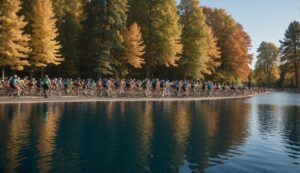📦 FREE Shipping
How to Train for a Sprint Triathlon: Guide to Race Day 2024!

Training for a sprint triathlon has been one of the most invigorating decisions I’ve ever made. You might wonder: How to Train for a Sprint Triathlon? A sprint triathlon is a shorter version of its endurance counterparts, making it an excellent choice for those looking to dip their toes into the triathlon world.
Sprint distances usually involve a 500/750m swim, a 20km bike ride, and a 5km run. This format serves not only as an entry point for beginners but also offers a fast-paced challenge for experienced athletes looking to improve their speed and technique.

My journey began with understanding the different distances in triathlons. It ranges from the super sprint, which is even shorter than the sprint, to the full Ironman World Championship distances that demand extreme endurance. The sprint triathlon strikes a perfect balance, offering a challenge that’s substantial yet achievable with dedication and structured training.
Focusing on a balanced training regimen has been crucial. I distribute my efforts across swimming, cycling, and running—the three disciplines of triathlon—to ensure steady progress and prevent burnout. To accommodate beginners, most sprint triathlon training plans suggest at least one session of each discipline per week, progressively increasing the intensity and duration as the race day approaches. Embracing this routine has steadily nudged me towards improving fitness levels, and the excitement of nearing race day is a feeling like no other.
Creating Your Training Plan
Crafting a successful training plan for a sprint triathlon is thrilling! It’s all about knocking down personal milestones and gearing up for an amazing race day.
Setting Achievable Goals
My training journey begins by establishing clear, realistic goals. I strive to conceive milestones that inspire yet remain within my reach – like completing my first sprint triathlon or improving my previous finish time.
- Define my finish goal: Complete the race or set a specific time.
- Outline incremental objectives: Weekly or monthly targets that keep me on track.
Planning Training Frequency
Consistency is key, so I plan how many days per week I can dedicate to training. Normally, I aim for three to six sessions each week, ensuring I have enough recovery time.
- Swim: 1-2 sessions per week.
- Bike: 1-2 sessions per week.
- Run: 1-2 sessions per week.
Understanding Triathlon Training Phases
I break down my training into phases: base, build, peak, and recovery. Each phase serves a specific purpose:
- Base: Build endurance with moderate intensity (e.g., Zone 2).
- Build: Increase intensity, introduce race pace.
- Peak: Fine-tune fitness, test race pace, taper training.
- Recovery: Low intensity, help muscles recover post-race.

Incorporating Training Zones and Intensity
I utilize training zones to gauge my effort. By monitoring my heart rate, I can train at various intensities:
- Zone 2: Foundation for endurance, where I spend most of my training.
- Threshold: Push my limits, prepare for race intensity.
Balancing the Three Disciplines
I ensure a balanced approach by evenly distributing my focus across swimming, biking, and running. It’s crucial to avoid overtraining one discipline at the expense of another:
- Swim: Enhance technique, open water practice.
- Bike: Build leg strength, long rides at a consistent pace.
- Run: Improve cadence, incorporate brick sessions (bike-to-run transitions).
Choosing the Right Training Plan
I search for a structured plan that fits my level and goals. Typically, a 12-week sprint triathlon training plan is a solid choice, but it’s essential to select a program that aligns with my time constraints and fitness level.
- Search criteria: Duration, specificity (beginner, intermediate, advanced).
- Program components: Workouts description, rest days, incremental load.
With the right plan, attitude, and a dash of determination, I’m ready to take on the challenge and cross that finish line with a sense of accomplishment!
Essential Techniques and Skills

I’ve discovered that focusing on technique and efficient transitioning between disciplines are crucial to excelling in a sprint triathlon. Let me share the specific skills that I’ve found essential in each area of the event.
Mastering Swimming Technique
In the swim portion of a triathlon, maintaining a streamlined position aids in conserving energy and improving speed. I practice sighting regularly to navigate effectively in open water and to swim in a straight line, which is vital for open water swims. My sessions include various drills to perfect my stroke and breathing—sidekick drills and catch-up stroke help me develop a constant breathing rhythm. I also train in my wetsuit to adapt to the buoyancy and range of motion it provides.
Cycling Proficiency and Transition
On the bike, I’ve honed my cycling technique by mastering shifting gears efficiently for speed and control. Bike handling skills are key, especially when tackling the corners and hills during a bike ride. I incorporate brick workouts into my routine, alternating cycling and running to prepare my legs for the transition—it’s one of my favorite ways to simulate the bike-to-run changeover.
| Bike Skills | Description |
|---|---|
| Gear Shifting | Adjust gears to maintain a steady cadence. |
| Hill Climbing | Use power strokes for climbs. |
| Transition Practice | Swiftly switch from bike to run. |
Running Tactics and Efficiency
For the running section, I work on maintaining a comfortable yet quick cadence, which helps with endurance and minimizing fatigue. Running technique is also about conservation of movement, making sure every stride is efficient. I’ve found that incorporating intervals at race pace trains my body to handle the speed I need in the race. Focusing on brick workouts, where I transition from biking to running, allows me to adapt to the switch in disciplines smoothly.
In my experience, refining these techniques and skills has significantly improved my performance across all three disciplines in a sprint triathlon.
Physical and Mental Preparation
As we embark on the journey of sprint triathlon training, it’s pivotal for me to weave both the strengthening of my body and the fortification of my mind into the fabric of my regimen.
Incorporating Strength and Cross-Training
I recognize the power of strength training as it contributes significantly to my overall triathlon performance. By including resistance training twice a week, I enhance not only my endurance but also resist injury. My go-to exercises are:
- Squats for leg strength
- Planks for core stability
- Deadlifts for my back and posture
Incorporating cross-training activities like yoga and Pilates is essential for my flexibility and muscle balance—it’s not all about power; it’s about strength in versatility.
Managing Recovery and Avoiding Injury
Recovery is non-negotiable in my training plan. I’ve learned that the quality of recovery and rest is just as crucial as the workouts themselves. Here’s what I keep track of:
- Rest days: I schedule at least one full rest day per week.
- Rate of perceived exertion (RPE): Monitoring my exertion helps me avoid overtraining.
- A post-workout cool-down and stretching are mandatory for me; I include a gentle swim or a bike at a leisurely pace.
Building Mental Toughness and Focus
Mental fitness is as important to me as physical stamina. Here’s how I bolster my mental fortitude:
- Visualization techniques help me stay focused and success-oriented.
- Setting small, attainable goals keeps me motivated and I celebrate these milestones.
- I practice mindfulness meditation to manage stress and keep my concentration sharp during races.
My physical and mental preparation are the cornerstones on which I build my triathlon success. I tackle each session with an eagerness, thrilled for the progress I’m about to make.
Race Day Strategy and Nutrition
My performance in a sprint triathlon hinges on meticulous planning, especially on race day. From seamless transitions to tailored nutrition and gear selection, it’s all about precision and personalization.
Perfecting Race-Day Transitions
Swim to Bike:
- Practice is key; I rehearse my transitions to be smooth and swift.
- I place my equipment in the order I’ll use it to save precious seconds.
Bike to Run:
- I ensure my shoes are ready for a quick change.
- Hydration strategy is set, with easy-access bottles on my bike.
Tailoring Nutrition for Training and Race Day
- Pre-Race: I eat a high-carb meal with a touch of protein, like oatmeal with nut butter, 2 hours before start time.
- During the Race: I focus on carbs and hydration, often with a sports drink. If I need an extra boost, a little caffeine can be a game-changer.
Choosing the Right Gear and Equipment
- Wetsuit: Not just any wetsuit – it has to cater to my swimming style and comfort.
- Bike: Tuned up and tested, because a smooth ride means a faster transition to the run.
- Helmet: Secured before I mount, because safety is non-negotiable.
My pre-race meal is fine-tuned to ensure I’m energized without feeling heavy. Post-transition, I rely on easily digestible carbs, and a splash of caffeine from gels or a drink only if I’ve trained with it. I’m always hydrated, pre-loading fluids before the race and maintaining intake throughout. My gear—wetsuit, bike, helmet—are second nature to me, each piece adding confidence and efficiency to my race strategy.
Frequently Asked Questions about How to Train for a Sprint Triathlon
I know you’ve got questions buzzing in your head about prepping for your first sprint triathlon. Let’s dive right in and answer some of the most common ones I’ve encountered.
What is the optimal number of weeks to prepare for a sprint triathlon?
Generally, I’d recommend an 8-week training plan for beginners. This allows sufficient time to build endurance and practice transitions, with less risk of injury compared to shorter preparations.
What’s a good sprint triathlon training plan for beginners?
A solid plan balances swimming, cycling, and running throughout the week. It should progressively increase in intensity and volume, including a mix of sprint intervals, longer endurance sessions, and brick workouts combining bike and run.
How can I effectively balance swim, bike, and run training for a sprint triathlon?
I aim to allocate my training evenly. If swimming is my weakest discipline, I focus a bit more on it without neglecting cycling and running. Consistency is key, so I spread workouts for all three disciplines across the week.
How many rest days should I incorporate before race day in sprint triathlon training?
I like to have one to two rest days in the week leading up to the race. It ensures my body is well-rested and primed for the event, giving me the confidence to perform my best.
To what extent should I increase my training intensity to excel in a sprint triathlon?
Incremental increases in intensity are vital for improvement. Each week, I up my training intensity slightly, ensuring my body adapts and gains the strength and speed needed without overtraining.
Are there any recommended triathlon training plans available online for free?
Yes, there are. Websites like TrainerRoad and various triathlon-specific forums offer free plans suitable for different skill levels. These plans give me structured workouts and help me measure my progress.
Is your question “How to Train for a Sprint Triathlon?” answered? Leave me a comment and make sure to also check out Triathlon Equipment and What is an Ironman Run.





